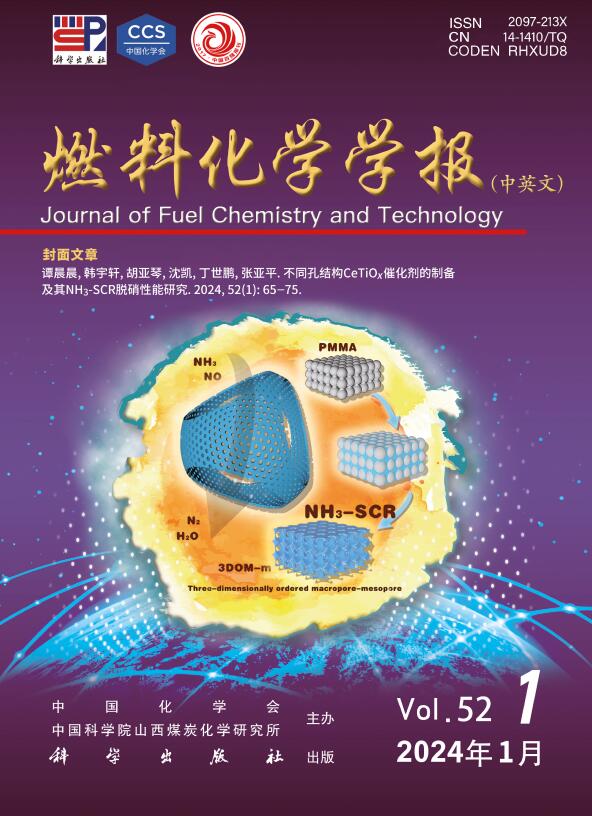铜基异质结电催化硝酸还原制氨催化剂
Q3 Energy
引用次数: 0
摘要
铜基催化剂因其低氢沉淀活性和高氨选择性而在电催化硝酸还原制氨领域受到广泛关注。然而,它们仍然面临稳定性差和活性低的挑战,这阻碍了它们的进一步应用。在此,我们提出了一种氮掺杂多孔碳负载的Cu2O/Cu异质结催化剂用于硝酸盐还原。高分辨透射电镜(HRTEM)和x射线衍射(XRD)结果证实了Cu2O/Cu异质结的存在,这是催化反应的活性相。氮掺杂多孔碳作为载体不仅提高了催化剂的稳定性,而且有利于活性位点的暴露和分散。在−1.29 V(相对于RHE)下,氨的最大产率达到8.8 mg/(mg·h),法拉第效率为92.8%。本研究还阐明了异质结中Cu2O-to-Cu比对催化性能的影响,从而为设计高效的硝酸还原氨催化剂提供了有价值的见解。本文章由计算机程序翻译,如有差异,请以英文原文为准。
Cu-based heterojunction catalysts for electrocatalytic nitrate reduction to ammonia
Copper-based catalysts have garnered wide attention in the field of electrocatalytic nitrate reduction for ammonia production due to their low hydrogen precipitation activity and high ammonia selectivity. However, they still face challenges pertaining of poor stability and low activity, which hinder their further application. Herein, we present a Cu2O/Cu heterojunction catalyst supported on nitrogen-doped porous carbon for nitrate reduction. High resolution transmission electron microscopy (HRTEM) and X-ray Diffraction (XRD) results confirm the presence of Cu2O/Cu heterojunctions, which serve as an active phase in catalysis. The nitrogen-doped porous carbon as a carrier not only enhances the catalyst's stability, but also facilitates the exposure and dispersion of active sites. At −1.29 V (vs. RHE), the maximum production rate of ammonia reaches 8.8 mg/(mg·h) with a Faradaic efficiency of 92.8%. This study also elucidates the effect of Cu2O-to-Cu ratio in the heterojunction on catalytic performance, thereby providing valuable insights for designing efficient nitrate reduction catalysts for ammonia production.
求助全文
通过发布文献求助,成功后即可免费获取论文全文。
去求助
来源期刊

燃料化学学报
Chemical Engineering-Chemical Engineering (all)
CiteScore
2.80
自引率
0.00%
发文量
5825
期刊介绍:
Journal of Fuel Chemistry and Technology (Ranliao Huaxue Xuebao) is a Chinese Academy of Sciences(CAS) journal started in 1956, sponsored by the Chinese Chemical Society and the Institute of Coal Chemistry, Chinese Academy of Sciences(CAS). The journal is published bimonthly by Science Press in China and widely distributed in about 20 countries. Journal of Fuel Chemistry and Technology publishes reports of both basic and applied research in the chemistry and chemical engineering of many energy sources, including that involved in the nature, processing and utilization of coal, petroleum, oil shale, natural gas, biomass and synfuels, as well as related subjects of increasing interest such as C1 chemistry, pollutions control and new catalytic materials. Types of publications include original research articles, short communications, research notes and reviews. Both domestic and international contributors are welcome. Manuscripts written in Chinese or English will be accepted. Additional English titles, abstracts and key words should be included in Chinese manuscripts. All manuscripts are subject to critical review by the editorial committee, which is composed of about 10 foreign and 50 Chinese experts in fuel science. Journal of Fuel Chemistry and Technology has been a source of primary research work in fuel chemistry as a Chinese core scientific periodical.
 求助内容:
求助内容: 应助结果提醒方式:
应助结果提醒方式:


